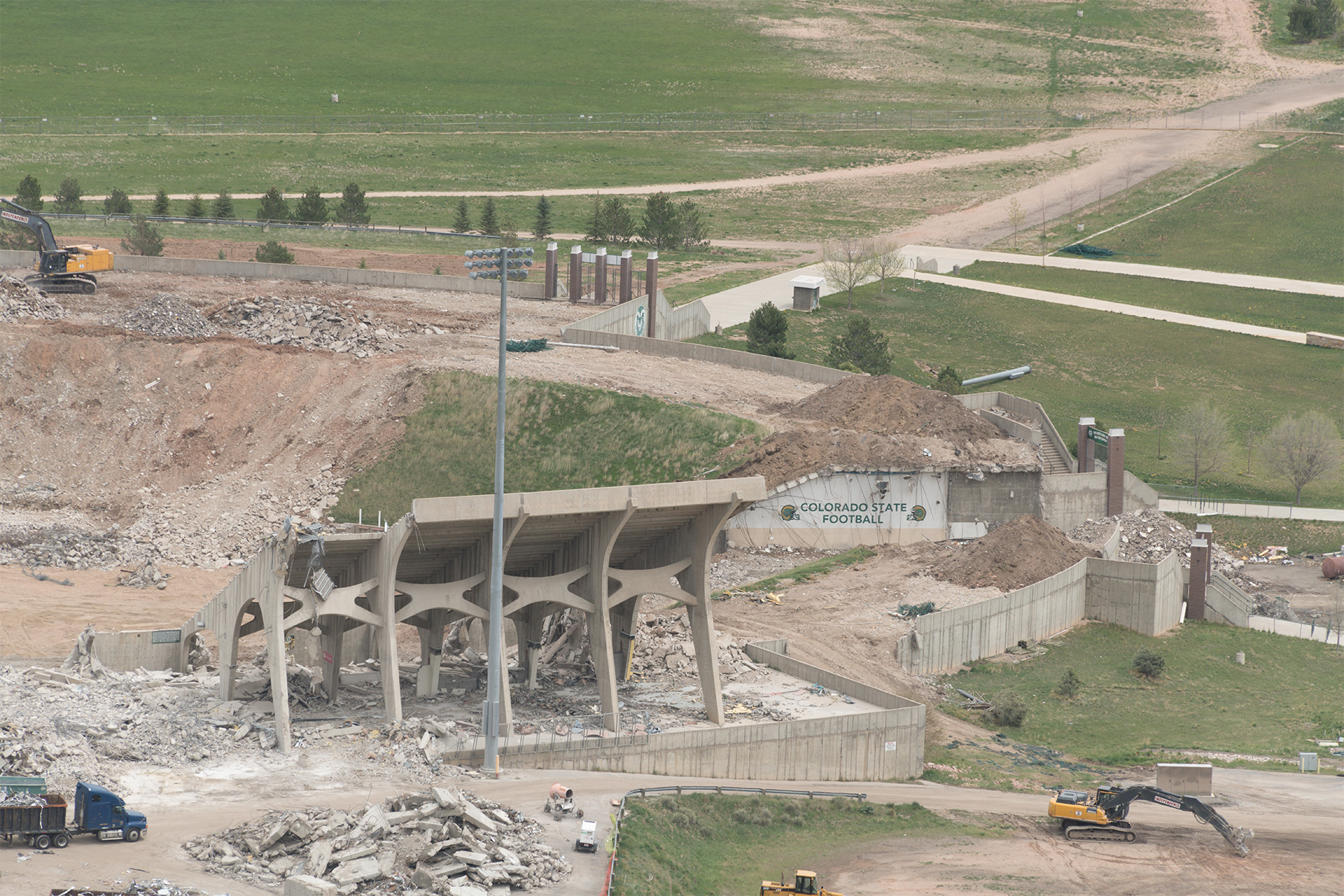
The Hughes Stadium site in 2018.
The site that once housed Hughes Stadium could soon provide much-needed affordable housing for Colorado State University employees, as well as community health care and child care services, in a project that will also have a positive environmental impact by putting affordable homes, trail connections and open space closer to where people work.
The project is an example of CSU’s efforts over the decades to use its property – in partnership with the City of Fort Collins and private developers – for multifaceted projects that benefit both the campus and the larger community. Examples of past projects include the Rigden Farm neighborhood and shopping center, the Campus West area between Elizabeth Street and City Park, and the CentreTech parcel, which is now home to Columbine Health Systems facilities and other community amenities.
“These are examples of collaborative efforts between the City of Fort Collins and Colorado State University, where the outcomes of that collaboration resulted in a community good,” said University Planner Fred Haberecht, who is among the leaders at CSU working on the Hughes property redevelopment.
In addition to the community and housing benefits planned on the site, almost half of the Hughes acreage would remain open and green space, with connectivity to existing trail infrastructure.
Designed to respond to employee concerns
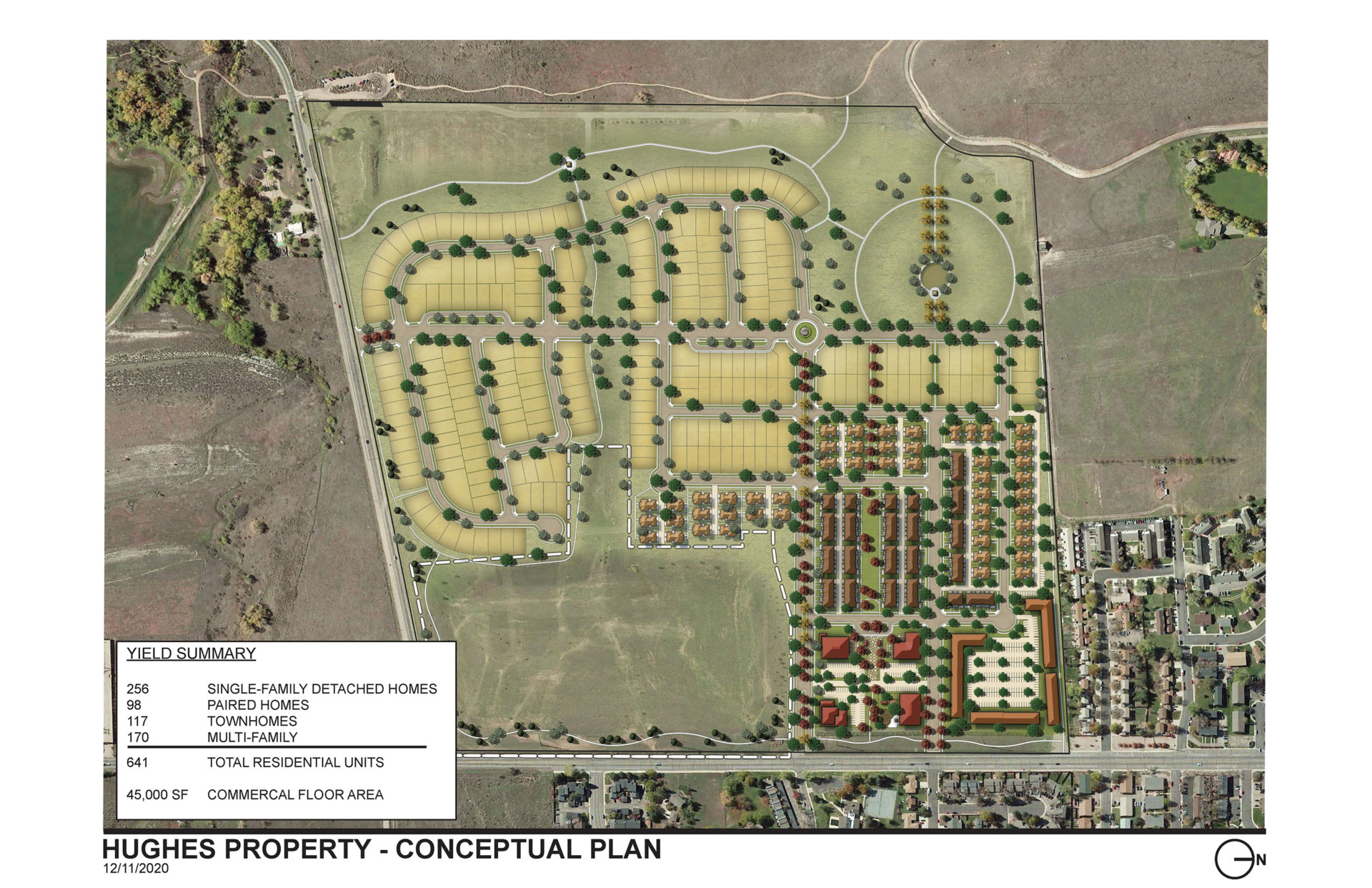 Aware of the dire need in the community for affordable housing, in 2015 CSU’s President, Tony Frank, appointed a Housing Solutions Task Force. The Hughes project took shape after surveys affirmed that the cost of housing was a major concern for CSU employees.
Aware of the dire need in the community for affordable housing, in 2015 CSU’s President, Tony Frank, appointed a Housing Solutions Task Force. The Hughes project took shape after surveys affirmed that the cost of housing was a major concern for CSU employees.
In 2017, an Employee Voice survey conducted jointly by Classified Personnel Council, Administrative Professional Council and Faculty Council gathered more than 2,000 responses from CSU’s 7,224 active employees at the time – a 27.8% response rate. Housing emerged as one of the top concerns, along with health care, child care, transportation, and the struggle to keep up with the cost of living. Subsequent surveys have shown that housing remains a top priority.
The 2017 survey report noted: “Employees shared how the high cost of housing forces them to live farther from campus, which in turn creates other financial constraints. Many experience housing as a significant strain on their budget, sometimes taking up 50% of their monthly budget, while others are frustrated by their inability to save enough to purchase a home. Employees report experiencing significant stress due to housing challenges.”
One employee quoted in the report said, “I worry about not having enough money for housing and paying other bills. If I can’t pay rent, I worry about being homeless. Which is a reality for me.”
The University took action in 2018 to raise all employee salaries to a living wage. But even at a living wage for the region (at the time a baseline of $30,000 for a salaried employee), many couldn’t afford the cost of housing. It is a concern CSU President Joyce McConnell has heard repeatedly from employees since she joined CSU in 2019.
The Board of Governors of the CSU System, where Frank now serves as chancellor, considered how the 161-acre Hughes property could combine affordable and attainable housing for employees with child care and health care facilities that could also serve the surrounding community. CSU hopes to move forward with the project, which is under discussion with the City of Fort Collins.
Significant community benefits
The project CSU has designed includes more than 70 acres of open green space and connections to the city’s trail system – nearly half the parcel’s total acreage.
In addition to affordable and attainable housing, child care and health care facilities, the project has evolved to also include a transit station to allow employees to easily commute to campus while reducing the university’s overall carbon footprint. Estimates indicate the project would eliminate 1.5 million commuting miles annually, eliminating about 430 metric tons of carbon dioxide emission per year – a 7% reduction in CSU’s commuting carbon impact. In addition, the homes planned for the site include solar-energy and water-saving technology options.
The plan includes a mix of apartments and single-family homes on the site, with 100% of the rental units meeting the federal standard for affordable housing. There will also be homes available for purchase, a portion of which will be “attainable” – priced at or below the market rate in Fort Collins.
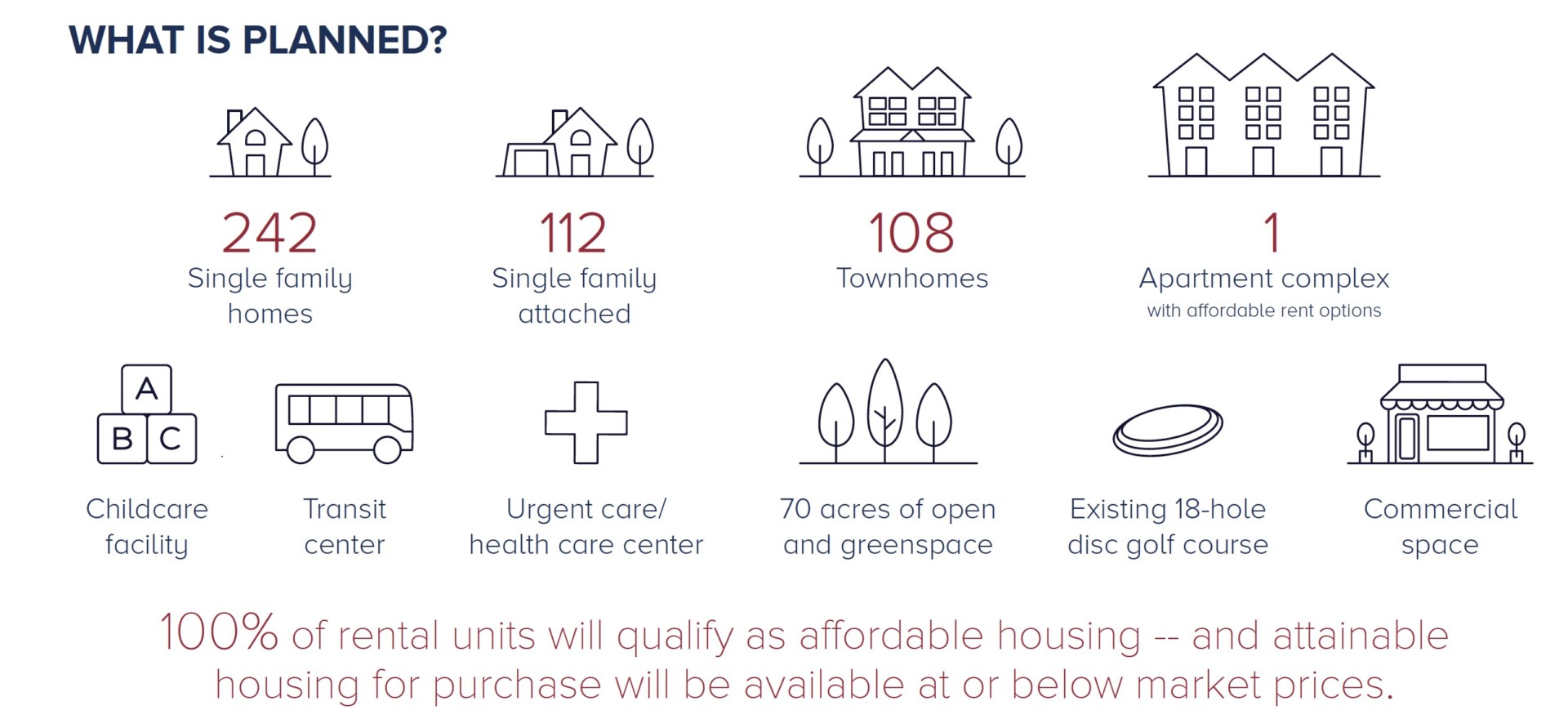 All of the housing will give CSU employees preference. The apartments will be rented exclusively to CSU employees until that demand is satisfied and then become available to the community. Homes for sale will have an early-priority period during which CSU employees will have the first chance to buy them. If not all homes are purchased within this window, the remaining ones will be available to the community.
All of the housing will give CSU employees preference. The apartments will be rented exclusively to CSU employees until that demand is satisfied and then become available to the community. Homes for sale will have an early-priority period during which CSU employees will have the first chance to buy them. If not all homes are purchased within this window, the remaining ones will be available to the community.
“Our faculty and staff tell us that finding an affordable place to live in Fort Collins is one of their top concerns, so we must pursue every avenue to create housing in our community that’s truly within reach for CSU employees,” said McConnell. “With the Hughes redevelopment project, we will take an important step in making Fort Collins a place where our people can afford to live where they work. When we do that, we make both Fort Collins and CSU stronger and more sustainable.”
CSU is partnering with a private developer selected through the state’s competitive bid process, Lennar, to build the project, but the CSU System is overseeing all aspects of its design, said Brett Anderson, formerly CSU’s vice president for University Advancement who is now managing the Hughes redevelopment as a special assistant to Chancellor Frank.
“The bottom line is that we don’t believe this should just be a city for rich people,” Anderson said. “This project is about delivering affordable and attainable housing that supports our community goals of equity and sustainability. Working with Lennar gives us the ability to deliver the housing and community benefits while still returning significant value to the Colorado taxpayers who own this land.”
The Hughes property is uniquely primed for the project because it’s already connected to the city’s infrastructure.
“This is a project that already has major utilities in place, unlike the sprawling greenfield developments further from the core of the city,” Haberecht said. “In many regards, this is a more sustainable development because it is tying into the existing city infrastructure.”
 He echoed the reality-check recognized over time by City staff and other Fort Collins leaders: that despite the green grasses growing on the site since the stadium’s demolition, this is a former gravel pit and parking lot with underground remnants of the massive concrete stadium that occupied the land for half a century.
He echoed the reality-check recognized over time by City staff and other Fort Collins leaders: that despite the green grasses growing on the site since the stadium’s demolition, this is a former gravel pit and parking lot with underground remnants of the massive concrete stadium that occupied the land for half a century.
“This is not pristine land or open space with unique qualities – this is a redevelopment project,” Haberecht said. “This is a project on land that was a sports venue surrounded by parking lots that is an infill piece of land, with adjacent development that is often of a higher intensity and density than what is proposed on the old stadium and parking lot site.”
Recent history of the property
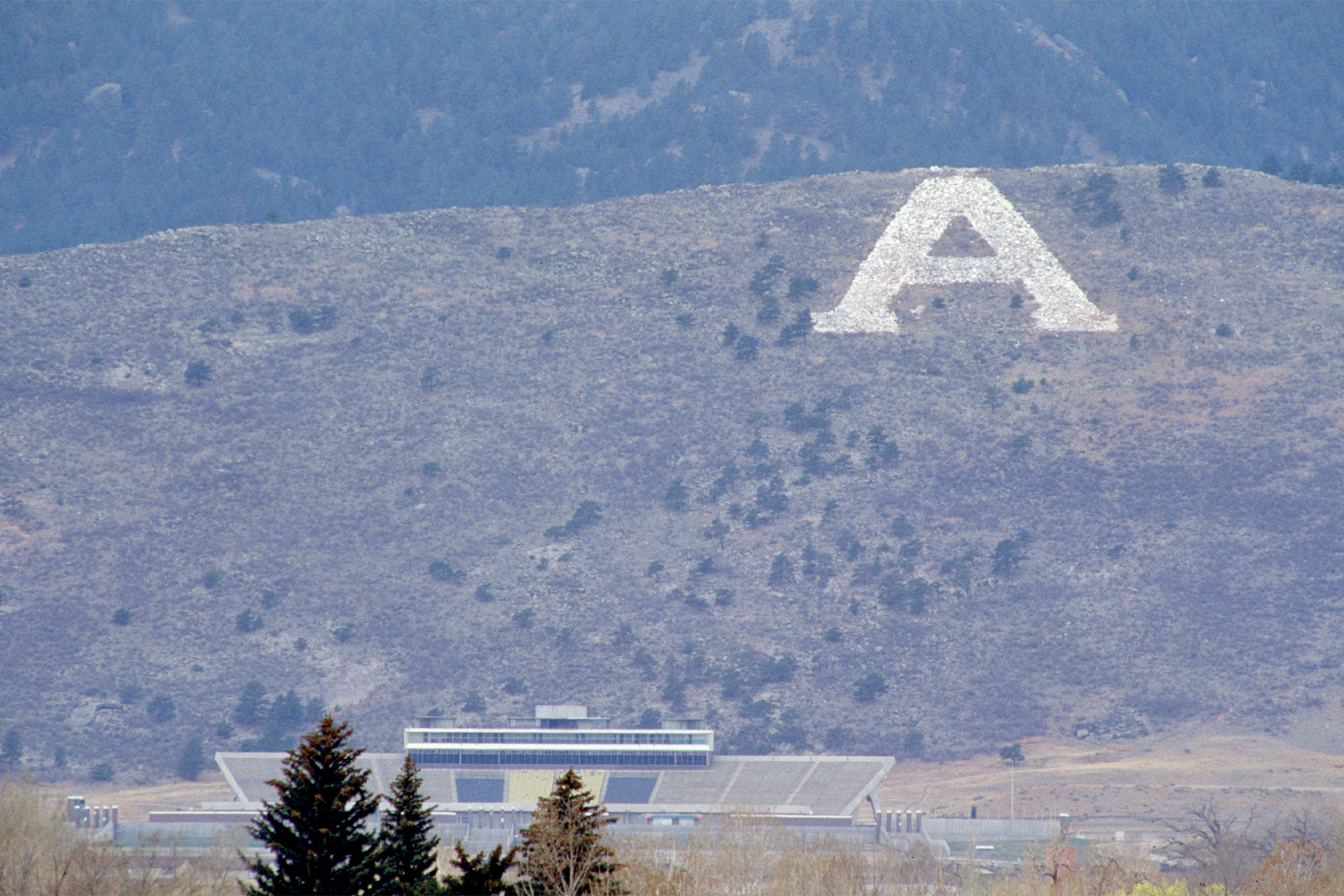
As early as 1901, CSU began acquiring parcels of land against the foothills to preserve for future uses. Over time, these became the Foothills Campus and the B.W. Pickett Equine Center. But the parcel that eventually became home to Hughes Stadium belonged to the federal government, which used the land as a gravel pit and equipment staging area during the construction of Horsetooth Reservoir.
Horsetooth was completed in 1949, and with no more interest in the property, the federal Department of Health, Education and Welfare granted the land to CSU with the understanding it would be used for a future stadium and other educational purposes for 20 years (a requirement that expired in the 1970s). When CSU took ownership in the 1950s, the gravel pit still fronted Overland Trail, and 20 acres on the north end of the property were being used for dryland farming.
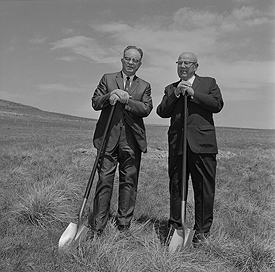
At the time it obtained the property, the university was struggling with old and outdated football facilities at Colorado Field on campus, described as “a glorified high school field on a college campus.” After a 1958 game against the University of Colorado, the Buffaloes vowed not to play CSU again because of the lack of a stadium. Despite strong public pressure to keep football on campus, President Bill Morgan determined the best option for a new stadium was the parcel near the foothills.
CSU opened Hughes Stadium in 1968.
Concerts were held occasionally at Hughes, including shows by Bob Dylan, the Rolling Stones, the Beach Boys, and Elton John. A 1978 lawsuit by the Miller family who lived north of the stadium put an end to concerts there.
Almost 50 years after its construction, Hughes Stadium was in need of expansion and significant structural repairs. The uneven bedrock and expansive soils underlying Hughes led to structural issues over the life of the stadium. This resulted in a significantly deteriorated structure, making any future expansions prone to all the same problems. So, in 2017, CSU moved football back to campus to the newly constructed Canvas Stadium.
Demolition of Hughes Stadium was completed in 2018.
Working with the City
The Board of Governors of the CSU System owns the property and has responsibility for managing it on behalf of all Colorado taxpayers. As plans for an on-campus stadium began to solidify, University and System staff worked with the City of Fort Collins to discuss potential new uses for the property. At that time, while the site was not within the City limits, the University and City agreed it should be used to meet housing and other needs for the entire Fort Collins community.
At the City’s request, in February 2018 the Board of Governors petitioned for the Hughes property to be annexed into Fort Collins. Once annexed, the City designated the site as having “Transitional” zoning.
On Oct. 9, 2020, the Board of Governors approved a site plan for the property that articulated eight goals for its planned redevelopment and use:
- Serving the interests of the University, Larimer County, and the City of Fort Collins;
- Providing opportunities for open space and environmentally conscious development;
- Providing public access to adjacent trails and open spaces;
- Maintaining strong connection to existing offsite trail systems;
- Providing connections to bike trails and transit systems;
- Offering opportunities for affordable, attainable, and workforce housing;
- Meeting broader University and community needs, such as neighborhood retail, senior and child care services, health care facilities, and community facilities;
- Satisfying the University’s fiduciary duty to generate a financial return from the property, with such revenues from the use of the property supporting operations of the CSU System and Colorado State University, in order to benefit university employees, faculty and students, as well as the residents of Fort Collins, Larimer County and the state of Colorado.
These goals align with the Fort Collins City Plan’s identified core values and outcomes areas, including livability, sustainability and community. The Board’s site plan is also consistent with City Plan, including the structure map and its five focus areas.
Fort Collins and CSU leadership continue to grapple with issues of zoning and the appropriate process for developing the property. Meanwhile, a citizens’ initiative – scheduled to be on the local ballot in April 2021 – would force the City of Fort Collins to zone and attempt to buy the Hughes property for parks, recreation and open space. Even if the measure passes, however, the City can’t force the Board of Governors to sell the property.
Other similar projects
The Hughes project isn’t the first time that CSU has developed its land with an eye toward long-term community benefits. The University is currently partnering with Timberline Church on a land swap and development that will include attainable housing partly earmarked for CSU employees. Other projects over the decades that have provided community good because of cooperative work among CSU, private developers, and City planning experts include:
- The 1990s – Rigden Farm – From 1958 through the late 1990s, a 328-acre parcel of land located at Drake and Timberline roads was home to the CSU Agricultural Campus-East. Today, it is a master planned community that is nearing completion after 20 years of development. Rigden Farm is now home to a neighborhood shopping center, a variety of housing units at varied price points, and a senior living community.
- The 1980s – CentreTech – From 1957 into the 1980s, the parcel of land located between Shields Street and Research Boulevard north of Drake Road was the CSU Agricultural Campus-South. Today, it is home to a variety of community amenities including several Columbine Health Systems facilities.
- The 1970s – West Elizabeth – Until the 1970s, the CSU Animal Reproduction and Equine Teaching and Research Center (“The Bull Farm”) was located on the northwest corner City Park Avenue and West Elizabeth Street. Thirty acres of the 75-acre parcel was retained for CSU married student and graduate student housing, and the remainder sold to private student housing developers. The resulting developments provide close-in housing for students on the busiest transit corridor in Fort Collins.
Information and answers to frequently asked questions about the project are online at the Hughes Redevelopment webpage.